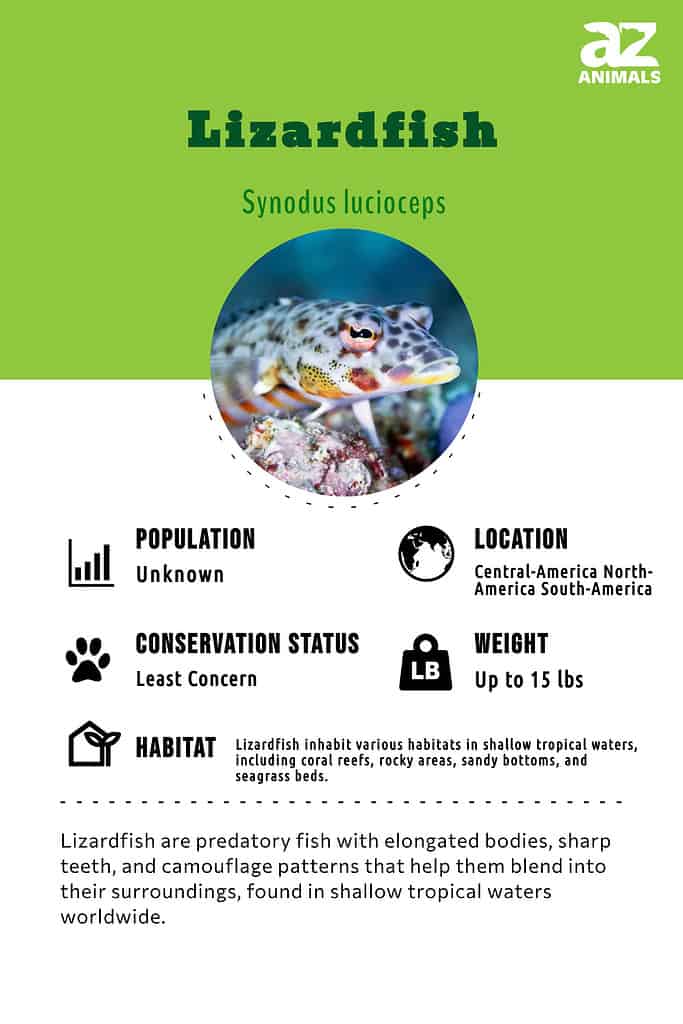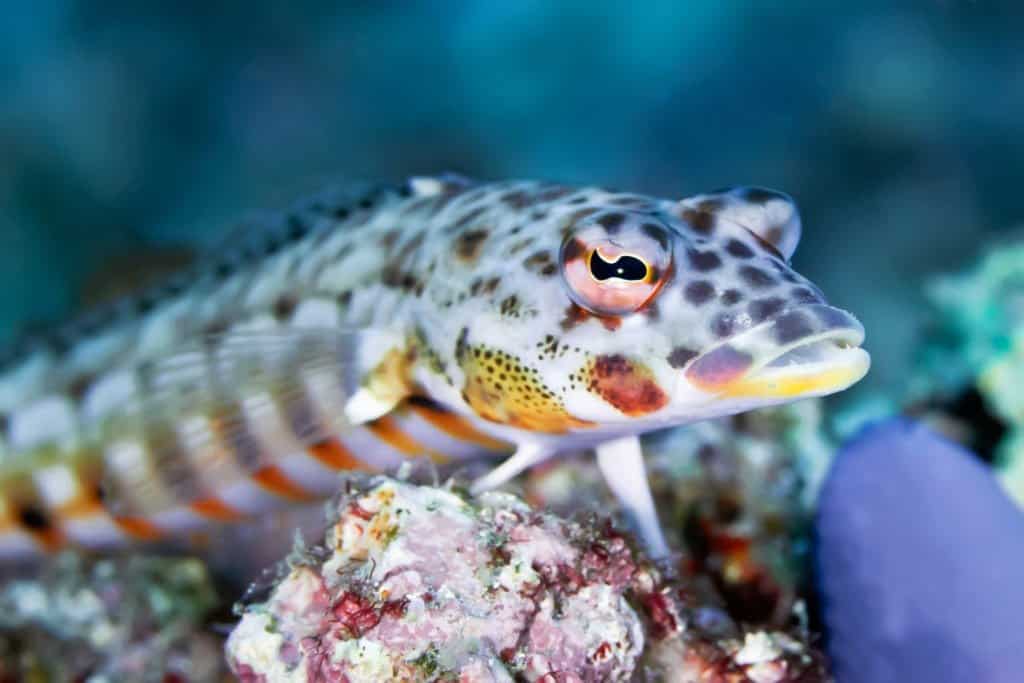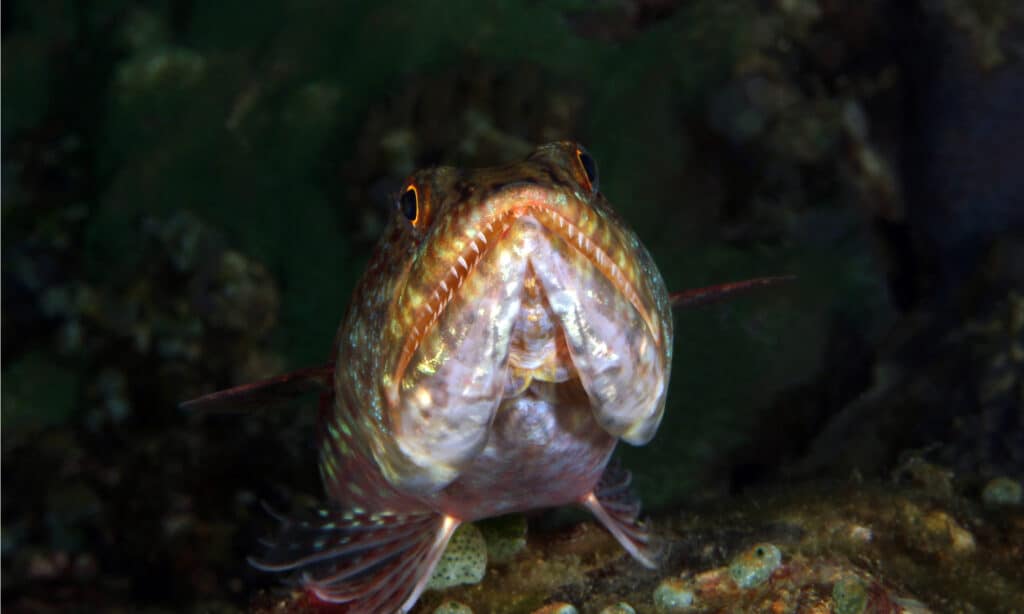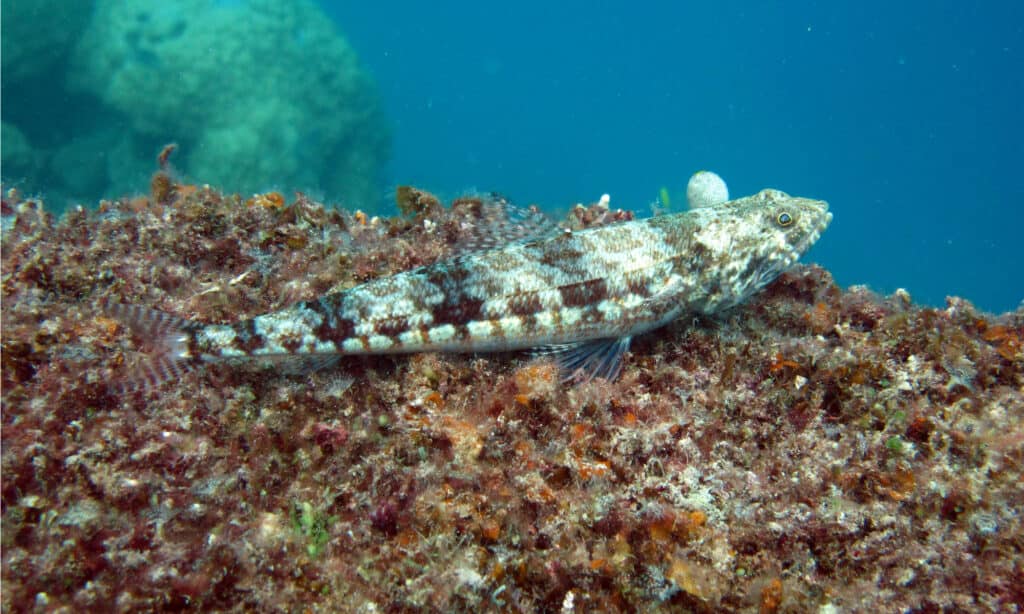Lizardfish
Synodus lucioceps
The lizardfish can camouflage itself against the sandy bottom to avoid predators.
Advertisement
Lizardfish Scientific Classification
- Kingdom
- Animalia
- Phylum
- Chordata
- Class
- Actinopterygii
- Order
- Aulopiformes
- Family
- Synodontidae
- Genus
- Synodus Scopoli
- Scientific Name
- Synodus lucioceps
Read our Complete Guide to Classification of Animals.
Lizardfish Conservation Status
Lizardfish Facts
- Prey
- Fish, shrimp, and squid
- Group Behavior
- Solitary
- Fun Fact
- The lizardfish can camouflage itself against the sandy bottom to avoid predators.
- Estimated Population Size
- Unknown
- Biggest Threat
- Overfishing
- Most Distinctive Feature
- The lizard-like head and sharp teeth
- Other Name(s)
- Grinners
- Gestation Period
- A few days
- Optimum pH Level
- Varies
- Habitat
- Oceans and seas
- Predators
- Larger fish
- Diet
- Carnivore
- Type
- Ray-finned fish
- Common Name
- Lizardfish
- Number Of Species
- 57
View all of the Lizardfish images!

The lizardfish is a family of around 57 different species (the most common of which are probably the inshore and brushtooth lizardfish) that live mainly near the coast.
Lizardfish have a huge mouths full of teeth, including on their tongues. Despite the lizardfish’s sharp teeth, they are not very dangerous to humans. They are also neither poisonous nor venomous in any manner. But even though lizardfish are edible, they are not usually caught for food or aquarium purposes.
3 Lizardfish Facts

The distinct appearance of juvenile lizardfish is so dissimilar to that of adults that they were once mistakenly believed to be completely separate species.
©Aleksei Alekhin/Shutterstock.com
- An American submarine called the USS Lizardfish was briefly active between 1944 and 1946. It was later transferred to the Italian Navy in 1960 and renamed the Evangelista Torricelli.
- The Bombay duck isn’t really a duck at all, but rather a species of lizardfish native to the Indian coast. It is not entirely clear how the species got its name.
- The juvenile lizardfish look so different from the adults that at one time they were thought to be entirely different species.
Classification and Scientific Name
The scientific name of the lizardfish family is Synodontidae. This is derived from a Greek term meaning united or grown together teeth. There are more than 50 species divided across four genera.
Appearance
The lizardfish is characterized by a long, slightly cylindrical body, measuring up to 2 feet long, with a head resembling a lizard and a pointed snout. It has a mouth full of sharp, slender teeth, including on the tongue. Their splotched or mottled skin, which ranges between white, black, olive, brown, and even purple, helps them remain camouflaged against the dirty soil.
Evolution and Origins
During the NORFANZ expedition on May 30, 2003, a Deepsea Lizardfish was captured by trawling at a depth ranging from 325 meters to 497 meters on Norfolk Ridge, located south of Norfolk Island.
The species is commonly found in shallow coastal areas such as salt-water creeks, rivers, bays, and sounds, as well as along open beaches with mud or sand substrates; it can also venture into deeper waters up to 180 meters along the continental shelf.
The deepsea lizardfish resides at a staggering depth of 6,900 feet, making it the planet’s deepest super predator, devouring anything in its path! Equipped with razor-sharp fangs and possessing simultaneous male and female reproductive organs, it boasts adaptations that enable its survival in the deep, lightless realms.
Further, this voracious predator exhibits an ambush hunting strategy by burying itself in sand or mud, primarily preying on fish and small mobile invertebrates.
Distribution, Population, and Habitat

Lizardfish are predominantly located in shallow tropical waters across the globe, encompassing open oceans, estuaries, and lagoons.
©fishmonger/Shutterstock.com
Most lizardfish are found in shallow tropical waters worldwide, including open seas, estuaries, and lagoons. They usually lie partly submerged in sandy soil for protection against predators. Most species live in waters no more than 1,800 feet deep.
The one exception is the deep-sea lizardfish, which lives in the “midnight” or aphotic zone more than 3,000 feet deep. It is so deep that no sunlight can penetrate it. Temperatures there hover around 40 degrees Fahrenheit.
Many species of lizardfish are found in the Gulf of Mexico and around Florida, including the well-known inshore lizardfish. Another common species, the brushtooth lizardfish, is located in the eastern Indian Ocean. There were reports that the brushtooth was introduced into the Red Sea and the Mediterranean, but this might not be accurate.
According to the IUCN Red List of endangered species, the vast majority of lizardfish are considered to be of least concern. The rest are classified as data deficient (meaning there hasn’t been enough data gathered about the species to decide). More precise population data are not available. Unfortunately, many lizardfish die when they’re accidentally brought up as bycatch. Those that survive are usually thrown back into the water because they have little commercial value.
Predators and Prey

As a carnivorous creature, the lizardfish holds the status of an apex predator in certain oceanic regions.
©Daniel Lamborn/Shutterstock.com
The lizardfish is a carnivorous animal. In some parts of the ocean, it is considered the apex predator.
What eats the lizardfish?
Lizardfish are generally preyed upon by larger types of fish. As mentioned previously, their primary means of defense is to sit at the bottom of the sea and pretend to blend in with the soil. If they sense they’ve been spotted, then the lizardfish will dart away and try to find a new hiding spot on the bottom.
What does the lizardfish eat?
The lizardfish preys mostly on smaller marine animals, including anchovies, shrimp, and squid. Some species are active hunters that go out looking for food. Some species will sit at the bottom of the sea and wait for prey to come by. It will then capture prey with its sharp teeth.
Reproduction and Lifespan

The breeding period of the lizardfish can occur during different seasons throughout the year, although it typically reaches its peak during the summer.
©Alt Eduard/Shutterstock.com
The spawning season for the lizardfish can take place at various times of the year, but it usually peaks in the summer. Females deposit their eggs in shallow waters, and males will come by and fertilize them with their sperm.
While most species have defined sexes, deep-sea lizardfish are hermaphrodites, meaning they can produce both eggs and sperm simultaneously. This is an adaptation to their isolated deep-sea environment. They will have much greater reproductive success if they can mate with any other deep-sea lizardfish they come across.
The gestation period usually lasts just a few days. Juveniles receive no protection from their parents. After hatching, the fish will float freely in the water column, vulnerable to predators. A short time later, they descend to the bottom of the sea and begin feeding on prey.
The black spots near the guts are visible through their transparent, scaleless skin. The lifespan of the lizardfish is not well-estimated, but it may be somewhere in the range of seven to nine years.
Fishing and Cooking

The red lizardfish is a species of lizardfish that lives mainly in the western Pacific Ocean, spot on karimun jawa national park indonesia
©fikqy Fadilla/Shutterstock.com
Lizardfish are not generally fished commercially, but they are fished recreationally. Many of them are caught with a simple hook and line using natural bait such as shrimp or squid. The lizardfish can, in turn, be used as bait for larger fish. In the United States, the Gulf of Mexico and Florida are good fishing spots, especially for the inshore lizardfish.
The white flakey edible meat supposedly tastes good when fried, baked, or grilled in various recipes, but it may take some effort to remove the bones from the flesh. Fortunately, the fish is not poisonous in any way and is entirely safe to eat. In Japan, lizardfish can be turned into a delicious paste. This type of paste is called cured surimi and can be used in various recipes. Kamaboko, for instance, is made by forming this pureed surimi paste into steamed loaves. It is often served with dipping sauce.
View all 98 animals that start with LLizardfish FAQs (Frequently Asked Questions)
Where are lizardfish found?
They are found in shallow tropical waters all over the planet.
Can you eat lizardfish?
Yes, they are said to be quite tasty and edible when used in a number of different recipes, and the flesh is not known to be toxic or poisonous in any way. But the lizardfish is not often caught for commercial purposes and therefore might be hard to find in stores. Some people catch them for recreational purposes instead. It is possible to find many different species of lizardfish around the Gulf of Mexico and Florida areas.
How big do lizardfish get?
Lizardfish tend to grow no larger than 2 feet in size. However, some specimens have been recorded at 3 feet long.
How do you catch a lizardfish?
Lizardfish can be caught with a hook and line using high-quality bait such as shrimp or squid.
Is a lizardfish a lizard or a fish?
It is a fish with a head that looks like a lizard. This resemblance is purely coincidental.
How many species of lizardfish are there?
It is estimated that there are some 57 species of lizardfish divided into about four different genera.
Thank you for reading! Have some feedback for us? Contact the AZ Animals editorial team.
Sources
- , Available here: https://www.britannica.com/animal/lizardfish
- , Available here: https://oceanconservancy.org/blog/2020/05/21/deep-sea-lizardfish/
- , Available here: https://www.texassaltwaterfishingmagazine.com/fishing/education/fishy-facts/lizardfish

















